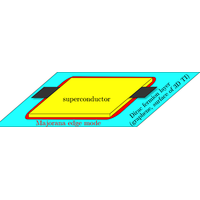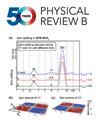通过镜面安德烈耶夫反射实现穷人的马约拉纳边缘模式
IF 3.7
2区 物理与天体物理
Q1 Physics and Astronomy
引用次数: 0
摘要
众所周知,三维拓扑绝缘体(3D TI)的表面支持超导体和磁性绝缘体界面上的手性马约拉纳边缘模式。由于材料组合的复杂性,这种状态尚未被观测到。在这里,我们展示了即使在没有磁绝缘体的情况下,如果无质量表面电子的费米级处于狄拉克点,也会出现螺旋马约拉纳边缘模式。狄拉克费米子的镜面安德列夫反射是这种效应的起源。虽然螺旋马约拉纳模式缺乏手性对应模式的拓扑保护,但简化的几何形状可能有利于实验观察。本文章由计算机程序翻译,如有差异,请以英文原文为准。

Poor man's Majorana edge mode enabled by specular Andreev reflection
It is known that the surface of a three-dimensional topological insulator (3D TI) supports a chiral Majorana edge mode at the interface between a superconductor and a magnetic insulator. The complexity of the materials combination is such that this state has not yet been observed. Here we show that a helical Majorana edge mode appears even in the absence of the magnetic insulator, if the Fermi level of the massless surface electrons is at the Dirac point. Specular Andreev reflection of Dirac fermions is at the origin of the effect. The simplified geometry may favor experimental observation of the helical Majorana mode, although it lacks the topological protection of its chiral counterpart.
求助全文
通过发布文献求助,成功后即可免费获取论文全文。
去求助
来源期刊

Physical Review B
物理-物理:凝聚态物理
CiteScore
6.70
自引率
32.40%
发文量
0
审稿时长
3.0 months
期刊介绍:
Physical Review B (PRB) is the world’s largest dedicated physics journal, publishing approximately 100 new, high-quality papers each week. The most highly cited journal in condensed matter physics, PRB provides outstanding depth and breadth of coverage, combined with unrivaled context and background for ongoing research by scientists worldwide.
PRB covers the full range of condensed matter, materials physics, and related subfields, including:
-Structure and phase transitions
-Ferroelectrics and multiferroics
-Disordered systems and alloys
-Magnetism
-Superconductivity
-Electronic structure, photonics, and metamaterials
-Semiconductors and mesoscopic systems
-Surfaces, nanoscience, and two-dimensional materials
-Topological states of matter
 求助内容:
求助内容: 应助结果提醒方式:
应助结果提醒方式:


